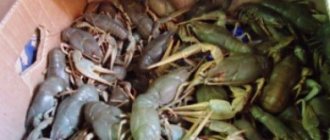The most difficult process in the crayfish trade is transportation
. Since the crayfish are traveling from Kazakhstan, and this is a 4-5 day journey, it is very important to receive them correctly after a long journey, just as it is very important to pack the crayfish correctly for the journey.
Crayfish can easily live in the refrigerator for about 2 weeks, but a very important point is to rinse them using the shower method. This is necessary so that the crayfish do not suffocate in their own waste.
So, long-distance transportation:
Place the crayfish with their paws down on top of each other in a layer of no more than 15 centimeters in plastic boxes with holes, rinse with water, cool in the refrigerator and load into the refrigerator. During transportation, the crayfish is afraid of weathering; for this, it is necessary to create conditions so that the moisture from the surface of the crayfish does not evaporate. Upon arrival at the unloading site, the crayfish should be unloaded in such a way as to ensure a smooth awakening. That is, do not create a sharp temperature change, otherwise the cancer may die. Unload it into a cool place and take a cold shower.
Let's unload fun and friendly!
Shower for crayfish to wake them up and flush out waste.
After the shower, we begin sorting, throwing out the dead and storing the living in boxes with a layer of no more than 8-10 cm, or simply releasing them into the pool. It all depends on what area you have at your disposal. Storage in boxes is more compact, because they can be stacked on top of each other.
Storage in boxes and in bulk. When crayfish is stored in water, it needs to be provided with a circulation of cold, clean water and a sufficient amount of oxygen. This is done using air compressors and drainage pumps.
You choose the pools, or containers for keeping crayfish, for yourself; these can be pools with brick walls, plastic cubic containers, those made of fiberglass sheets, or inflatable pools.
Read more: Position that is not a state civil position
You can store crayfish in refrigerators, providing them with a daily shower. I provide more detailed information (storage temperature, how to transport correctly, box models, water supply system, oxygen supply and circulation, etc.) only to my partners. Remember, crayfish are living creatures and they do not tolerate careless treatment.
IT IS STRICTLY PROHIBITED TO COOK DEAD CRAWFISH.
Crayfish meat is a tasty and very valuable product. Cooking these animals is quite simple. You can boil them until the shell turns red in very salty water. Dill, vegetables and spices can be used as seasoning. Crayfish acquire their red color during the cooking process due to the fact that all pigments, except red, in their chitinous shell are destroyed. In the finished animal, only fifteen to twenty percent of the carcass is edible. The meat is hidden inside the tail, legs and claws.
Crawfish often need to be stored for some time before being consumed. Most often, cages are used for this. Animals should be kept in the same body of water where they were caught. Boxes with slits or drilled holes can be used as cages. You should think about how to transport live crayfish as quickly as possible, since in cages they can start to eat each other. Crayfish need feeding if they are planned to be kept in a pond for more than one or two days. For feeding, you can use fresh fish, as well as nettles and other vegetation. They fight less often with each other for plant food.
Crayfish are usually transported in spacious boxes. No water is used. Air must enter the container in which animals are transported. They can only be laid in one row. You can use wet aquatic plants, moss or something else on the bottom and top. When deciding how to transport live crayfish in large quantities, you can think about installing intermediate shelves inside the boxes. Water should not accumulate at the bottom of the container in an amount that can cover the bottom layer of the animals.
Read more: Mortgage at Raiffeisenbank for salary clients
It is especially difficult to decide how to transport crayfish alive in the summer, since the temperature inside the vehicle should not rise too high. You can use ice to cover boxes with crayfish and tarpaulins to protect them from sunlight. It is better to carry out transportation at night, when there is no sweltering heat. You can try to additionally insulate the boxes for transporting crayfish with some materials.
It is believed that hungry crayfish tolerate transportation better, but the issue of feeding them before transportation must be decided depending on the circumstances. If the journey does not take much time, there will be no damage to the catch in any case. The faster the crayfish are delivered to where they are needed, the better. After arriving at the place, you will need to check all the animals, removing any that died on the way.
We are responsible for the quality of our products
Always fresh, always washed and only WILD crayfish in our online store.
Storage and transportation of crayfish
Most often, caught crayfish must be stored for some time before consumption. They are usually stored in cages. It must be borne in mind that in order to localize possible infectious diseases, crayfish in cages should be kept in the reservoirs from which they were caught. Low boxes made from boards with holes drilled in the walls, or boxes with slots, have proven themselves best as cages. Crayfish are well preserved in cages made of wooden planks or metal mesh.
Crayfish should be kept in cages for as little time as possible, since they eat each other, especially helpless individuals. When storing crayfish for more than 1-2 days in cages, they need to be fed so that they are better preserved and less likely to attack one another. The usual food is fresh fish. Crayfish can also be fed with nettles, alder leaves, potatoes, pea stems and other plant foods. It has been noticed that crayfish fight more often for fish than for plant food. In these fights, they lose their claws and suffer other injuries. To avoid this, it is better to feed crayfish with plant foods in cages.
Crayfish are usually transported without water, in spacious boxes. Wicker baskets are especially practical, as are wooden, cardboard and plastic boxes, as long as they have enough air holes.
Crayfish are placed in boxes about 15 cm high in only one row. It is recommended to lay a layer of damp moss, grass, nettles, aquatic plants, etc. on the bottom of the boxes, as well as on top of the crayfish. In higher boxes, intermediate shelves are made from slats so that the layers of crayfish do not fit tightly to each other. They can be transported safely and without intermediate partitions, layered with layers of damp moss. You need to put crayfish in boxes and cover them with moss as quickly as possible, before they start to move. If the crayfish begin to become active, they will quickly gather in heaps in the corners of the box. You need to be careful that the crayfish do not become covered with water that has collected at the bottom of the box.
When transporting crayfish in the summer heat, it is necessary to ensure that the temperature in the boxes does not rise too high. To do this, you need to cover the boxes from direct sunlight, place bags of ice around the boxes, etc. To maintain the desired temperature inside, the outside of the boxes can be lined with any dry material.
According to the recommendation of the Germans, crayfish should be allowed to dry for half a day after being caught before being placed in boxes. There is also an opinion that crayfish tolerate transportation better if they have not received food for some time before.
Crayfish are usually transported without water, in spacious boxes. Wicker baskets are especially practical, as are wooden, cardboard and plastic boxes, as long as they have enough air holes.
How to transfer crayfish over a long distance
If you catch crayfish and will be on the same body of water for some time, then you can store the crayfish in a regular cage. When moving to another body of water, it is advisable not to put the caught crayfish into the water of another river or river, because in this case they are at risk of acquiring infections.
Today, you can store crayfish in small wooden or plastic boxes with plenty of ventilation holes. Place the caught crayfish in the bottom of the boxes in only one layer. It is advisable to keep crayfish next to each other for as little time as possible due to mutual eating. If the crayfish are in the boxes for more than twenty-four hours, feed them first - put in several cleaned fish without scales and entrails. If you don’t have the opportunity to treat them with fish, then put a few potato tubers, alder leaves or aquatic grass in the boxes. The fight between crayfish will only be for fresh fish, so sometimes it is more profitable to feed them only with food of plant origin.
Crayfish do not need water during transportation; the main thing is a large amount of incoming air. On top of the crayfish you can put coastal grass, fresh leaves from trees or moss. Make sure that during transportation, the water flowing from the crayfish does not accumulate in one place and the crayfish do not look for their place in it.
When transporting crayfish in summer, the temperature inside the boxes should not rise above thirty degrees. If you have dry ice, you can use it to lower the temperature inside the boxes being transported.
And two more important recommendations. First, after catching crayfish, give them time to dry. Let all the moisture evaporate from their chitinous cover. And secondly, before moving long distances, do not feed them for a while. Let them be hungry. These two aspects will help you keep the transported crayfish alive longer than if they are neglected.
I wish you successful transportation of crayfish over long distances!
Transportation of crayfish
The caught crayfish are immediately placed in clean baskets, washed and stored in a place protected from the sun and draft wind. If the storage period is more than 6 hours, the crayfish are placed in flow-through cages.[ . ]
For transportation over short distances, crayfish are placed in baskets and boxes without packaging material in 6-7 rows, covered with a lid or lined with matting, delya and other material.[ . ]
For long-distance transportation, pre-dried crayfish are packed in a special container with a lining of moss, straw, soft shavings in 3-4 layers, belly down, tucking it in. The last row of each layer is placed with the belly facing the side wall.[ . ]
Crayfish are transported to short distances by road, and to long distances by rail or air transport.[ . ]
To avoid shaking in cars, boxes are placed on a mat. The car needs an awning or tarpaulin to protect it from the sun, wind, precipitation, etc. In the warm season, it is advisable to pour ice on the bottom of the body, covering it with a layer of straw, and place boxes with ice between the containers in which crayfish are transported.[ . ]
It is best to transport crayfish at night or early in the morning. In cold cloudy weather, transportation can be carried out during the daytime.[ . ]
Before transportation and upon arrival at the site, the crayfish are sorted, checking their viability. During examination, take the crayfish with two fingers in the middle of the cephalothorax. Crayfish that vigorously raise their claws upward are considered resilient. Crayfish with their claws down and foaming at the mouth are discarded. When storing crayfish, you should remember the need to tie the top of the basket with delya so that at night the crayfish cannot escape into a nearby body of water.[ . ]
Crayfish are classified as invertebrate animals, and its body is divided into 2 parts: the first is a segmented abdomen with a wide fin and the second part is the cephalothorax with a strong, large shell. There are two pairs of whiskers on the head, the eyes are located on stalks.
Storing crayfish immediately after catch.
To prevent the catch from being lost, it is necessary to take care of its safety immediately after catching. Before fishing, you need to prepare a durable box with holes for oxygen access. The box is lowered halfway into the water and, as you catch it, crayfish are placed in it. Next comes the transportation of crayfish.
You also need to transport crayfish correctly. To do this, wrap the box with crayfish in a wet rag. You can transport crayfish in a regular bag, you just need to wet it.
If possible, you can purchase special containers for transportation that tend to accumulate cold. But it should be remembered that even these measures will not help transport crayfish over long distances. The maximum lifespan of crayfish with this storage is 4 hours.
How to transport crayfish correctly?
Other fishing articles on the topic:
Crayfish breeding can occur in different scenarios. Entrepreneurs most often create either a pond farm or a factory farm. Most experts have come to the conclusion that of these two types of farms, pond farming is more profitable, since crayfish farming is.
Not everyone likes to catch crayfish with their hands. However, this is one of the most effective and ancient methods of fishing. If you move your hands carefully in the water, your catch will be very successful. Many people are afraid of crayfish bites. It's really painful and unpleasant.
Crayfish are classified as invertebrate animals, and its body is divided into 2 parts: the first is a segmented abdomen with a wide fin and the second part is the cephalothorax with a strong, large shell. There are two pairs of whiskers on the head, the eyes are located on stalks.
The body of the fly should be cone-shaped: it converges less steeply towards the bend of the hook and more steeply towards the head. The thread must be laid evenly, so that there are no dents or bulges on the body. When work on the body of the fly is completed, .
In order to enjoy fishing and bring home a lot of catch, the most important thing is to choose the right fishing gear. It is also necessary to pay special attention to the quality and condition of the gear to avoid breakdowns and defects. .
For successful fishing, the correct choice of location is not the least important. What is it first of all important to pay attention to in order for fishing to be successful? It is known that rivers or streams flowing into the reservoir bring with them.
To successfully fish on a lake, you need to know the maximum number of features, as well as know what kind of fish is found in it. In addition, the already acquired fishing skills in finding “fishy” places and selecting fish are very important.
The basis for fishing success is not only good weather and the presence of catchable bait, but also the correct installation of the bottom tackle rod. The donka must have a flexible and sensitive quiver tip, as well as a powerful inertia-free reel. In addition, paired with .
How to keep crayfish alive?
We bought live crayfish, but their cooking was delayed for 4 days. How to keep crayfish alive? 7 kg is no joke!))))))
Keep the crayfish alive. A very correct and necessary question. Dead crayfish are highly discouraged for consumption. Crayfish should not be stored in water. After some time, they begin to suffocate and die. Crayfish will remain alive without water for several days, provided certain conditions are met. The point here is that their gills are located inside the body, and this allows them to live in dry conditions for some time. Crayfish should be stored in a cool, damp place where there is sufficient fresh air circulation. A refrigerator is just what you need. By the way, periodic sprinkling with water refreshes them and keeps them alive.
We bought live crayfish, but their cooking was delayed for 4 days. How to keep crayfish alive? 7 kg is no joke!))))))
Before you start cooking crayfish, check the quality of the meat. It is possible that animals stored in the refrigerator may have suffered slightly. If you notice a low-quality product, the best thing to do is get rid of it! After all, if there is a dead individual among the crayfish, then the rest may begin to feed on it (by their nature, these arthropods are scavengers). All the more likely is that a dead individual may end up in the pan along with the living ones, and in this case grief will not be avoided. Be aware that if an unpleasant odor appears while storing crayfish in the refrigerator, this most likely means that one of the animals has died. He will need to be found and removed from the total mass of his remaining brothers.
Storage and transportation of crayfish
Most often, caught crayfish must be stored for some time before consumption. They are usually stored in cages. It must be borne in mind that in order to localize possible infectious diseases, crayfish in cages should be kept in the reservoirs from which they were caught. Low boxes made from boards with holes drilled in the walls, or boxes with slots, have proven themselves best as cages. Crayfish are well preserved in cages made of wooden planks or metal mesh.
Crayfish should be kept in cages for as little time as possible, since they eat each other, especially helpless individuals. When storing crayfish for more than 1-2 days in cages, they need to be fed so that they are better preserved and less likely to attack one another. The usual food is fresh fish. Crayfish can also be fed with nettles, alder leaves, potatoes, pea stems and other plant foods. It has been noticed that crayfish fight more often for fish than for plant food. In these fights, they lose their claws and suffer other injuries. To avoid this, it is better to feed crayfish with plant foods in cages.
Crayfish are usually transported without water, in spacious boxes. Wicker baskets are especially practical, as are wooden, cardboard and plastic boxes, as long as they have enough air holes.
Crayfish are placed in boxes about 15 cm high in only one row. It is recommended to lay a layer of damp moss, grass, nettles, aquatic plants, etc. on the bottom of the boxes, as well as on top of the crayfish. In higher boxes, intermediate shelves are made from slats so that the layers of crayfish do not fit tightly to each other. They can be transported safely and without intermediate partitions, layered with layers of damp moss. You need to put crayfish in boxes and cover them with moss as quickly as possible, before they start to move. If the crayfish begin to become active, they will quickly gather in heaps in the corners of the box. You need to be careful that the crayfish do not become covered with water that has collected at the bottom of the box.
When transporting crayfish in the summer heat, it is necessary to ensure that the temperature in the boxes does not rise too high. To do this, you need to cover the boxes from direct sunlight, place bags of ice around the boxes, etc. To maintain the desired temperature inside, the outside of the boxes can be lined with any dry material.
According to the recommendation of the Germans, crayfish should be allowed to dry for half a day after being caught before being placed in boxes. There is also an opinion that crayfish tolerate transportation better if they have not received food for some time before.
Shower for crayfish to wake them up and flush out waste.
Storing crayfish at home.
It is not always possible to immediately cook crayfish after purchasing crayfish. Therefore, after purchasing, the task is to keep the crayfish fresh and, most importantly, alive for as long as possible. There are several optimal ways to do this.
The most common method is storage in water. After purchasing, you need to place the crayfish in a deep container with water. It should be remembered that crayfish can easily “escape”, so choose a container with high walls. With this storage method, crayfish can live for several days. Just remember that the water in the container must be changed daily, and the arthropods must be fed once a day. Regular fish or lean meat is suitable for feeding.
If you need to keep crayfish fresh not for a few days, but for a few hours, you can simply place them in a plastic container and cover with a wet cloth. With this storage method, every hour you should re-wet the fabric in cold water.
You can also store crayfish in the refrigerator. To do this, clean crayfish are placed in a plastic bag and placed on the bottom shelf of the refrigerator. This method will help keep the crayfish fresh for no more than a day.
To prevent the catch from being lost, it is necessary to take care of its safety immediately after catching. Before fishing, you need to prepare a durable box with holes for oxygen access. The box is lowered halfway into the water and, as you catch it, crayfish are placed in it. Next comes the transportation of crayfish.
how to store crayfish in large quantities
Shower for crayfish to wake them up and flush out waste.
When crayfish is stored in water, it needs to be provided with a circulation of cold, clean water and a sufficient amount of oxygen. This is done using air compressors and drainage pumps.
I provide more detailed information (storage temperature, how to transport correctly, box models, water supply system, oxygen supply and circulation, etc.) only to my partners.
Remember, crayfish are living creatures and they do not tolerate careless treatment.
I hope for answers and wishes.
Storage conditions for crayfish
How to keep crayfish alive? It is no secret that these animals can do without water for some time, if favorable storage conditions are created for them. Crayfish themselves are aquatic creatures, and in order to be able to reproduce and live, they need water. But since their gills are located inside the body, this gives them a significant advantage over others - they can live on land for some time and not feel any discomfort.
How to keep crayfish alive? When you buy fresh animals, but do not intend to cook them right away, keeping them alive is very simple. The first and main condition is that the crayfish must be in a cold place in which air will constantly circulate. To maintain vital functions, they must be periodically sprayed with water - this will refresh the animals.
a_sunkar 04/11/2008, 10:51
I need to transfer crayfish from Uralsk to Almaty, there are not many crayfish - no more than 10 kg, a friend’s relatives want to transfer them. Question: how can I carry them on the plane? Some people say that you need to freeze them in the freezer and check them in as luggage. If you bring them back, they will thaw and they will even be alive. Some people suggest boiling them right there and carrying them already boiled. The flight takes 3 hours, I'm afraid that if you freeze them, they will thaw and the box will leak, but if the news is boiled, they won't go rotten?
I hope for answers and wishes.
What should you not do with crayfish?
How to properly store live crayfish? In the cool. But there is no need to overdo it: experts categorically do not recommend storing them in the freezer. Under such temperature conditions, animal meat can change its color and taste. In addition, as a result of freezing, the meat will become soft and lose all its beneficial qualities. The best way out in this situation would be to boil the crayfish and only then place their meat in the refrigerator. In this case, it is necessary to place the product in a glass container and place it on a free shelf. Such meat can be stored for a long time and will be an excellent snack for beer.
Transportation of crayfish
The caught crayfish are immediately placed in clean baskets, washed and stored in a place protected from the sun and draft wind. If the storage period is more than 6 hours, the crayfish are placed in flow-through cages.[ . ]
For transportation over short distances, crayfish are placed in baskets and boxes without packaging material in 6-7 rows, covered with a lid or lined with matting, delya and other material.[ . ]
For long-distance transportation, pre-dried crayfish are packed in a special container with a lining of moss, straw, soft shavings in 3-4 layers, belly down, tucking it in. The last row of each layer is placed with the belly facing the side wall.[ . ]
Crayfish are transported to short distances by road, and to long distances by rail or air transport.[ . ]
To avoid shaking in cars, boxes are placed on a mat. The car needs an awning or tarpaulin to protect it from the sun, wind, precipitation, etc. In the warm season, it is advisable to pour ice on the bottom of the body, covering it with a layer of straw, and place boxes with ice between the containers in which crayfish are transported.[ . ]
It is best to transport crayfish at night or early in the morning. In cold cloudy weather, transportation can be carried out during the daytime.[ . ]
Before transportation and upon arrival at the site, the crayfish are sorted, checking their viability. During examination, take the crayfish with two fingers in the middle of the cephalothorax. Crayfish that vigorously raise their claws upward are considered resilient. Crayfish with their claws down and foaming at the mouth are discarded. When storing crayfish, you should remember the need to tie the top of the basket with delya so that at night the crayfish cannot escape into a nearby body of water.[ . ]
It is best to transport crayfish at night or early in the morning. In cold cloudy weather, transportation can be carried out during the daytime.[ . ]
3. The activities of my company have not been suspended. How can I confirm that I am going to work?
— As stated in the same Decree of the Mayor of Moscow, citizens who are required to appear at their workplace during the period of self-isolation will be issued special passes. The procedure for issuing them should be determined by regulations prepared by the Moscow government. The document has not yet been published, so it is not yet clear how the special pass will be obtained. Nowadays, if you travel by car to or from work, it is advisable to have supporting documents with you. This may be a service ID or a copy of the employment contract.
On the Kamensk-Shakhtinsky-Volgograd highway near the city.
Kamyshin on the Don has a store that sells fish and live crayfish. This store is located 500 m from the traffic police post. In this store I purchased 50 kg of live crayfish for my son’s wedding. Driving with crayfish through the traffic police checkpoint, I was stopped by State Traffic Safety Inspectorate officers, they drove my car into the parking lot and began to say that I was illegally transporting crayfish, that the crayfish would be confiscated from me, and they also tried to accuse me of poaching. I explained that I bought crayfish from a store on the highway, but they didn’t want to listen to me. The store did not give me either a sales receipt or a cash receipt because they do not have a cash register.
Please explain what I violated and what articles of the Criminal Code or the Administrative Code my actions fall under. Were the traffic police officers right? and if not, then what norms of law should be referred to in a similar situation.
Your actions do not qualify as poaching. Therefore, the traffic police officers are wrong. I would also like to note that if a product is confiscated from you, traffic police officers are required to keep it unchanged.
Good afternoon, Vladimir! Your actions fall under the signs of an administrative offense provided for in paragraph 2 of Article 8.17 of the Code of Administrative Offenses of the Russian Federation “Violation of the rules for the extraction (catch) of aquatic biological resources.”
In addition, Article 256 of the Criminal Code of the Russian Federation provides for the illegal extraction (catch) of aquatic biological resources (actions aimed at removing them from the environment and (or) taking possession of them in violation of environmental legislation (for example, without permission obtained in accordance with the procedure established by law, in violation of provisions provided for by such a permit, in prohibited areas, in relation to certain types of aquatic biological resources prohibited for extraction (catch), at prohibited times, using prohibited fishing gear), provided that such actions are committed by a person using a self-propelled floating vehicle, explosives or chemicals, electric current or other methods of mass extermination of aquatic animals and plants, in spawning areas or on migration routes to them, in specially protected natural areas, in an environmental disaster zone or in an environmental emergency zone, or when such actions caused major damage .
If I received a cash receipt from the store for the purchase of 50 kg of crayfish, there would be no problems.
Please explain what I violated and what articles of the Criminal Code or the Administrative Code my actions fall under. Were the traffic police officers right? and if not, then what norms of law should be referred to in a similar situation.
Conclusion
It makes sense to store live crayfish in water only during transportation to the pan (that is, 3-4 hours), and the water must be taken from the place of capture.
The storage option in a container (large saucepan or aquarium) is suitable if the water is from a well (without chlorine) - 2-5 days. The water will have to be changed very often so that it does not overheat and remains aerated. This matter is complex, inconvenient, unprofitable and the result is doubtful.
It’s easier to keep the crayfish “dry”, or even better – to cook it on the spot.











